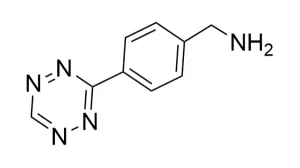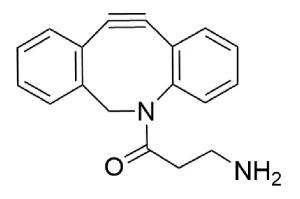t-boc-N-amido-dPEG®11-amine, product number QBD-10172, is a diamine-functionalized, homobifunctional, monodisperse PEGylation reagent with one of the two primary amine-reactive groups protected as a tert-butyl carbamate. Both ends of the molecule react with carboxylic acids, aldehydes, and ketones. Carboxylic acids react with this product to form amide bonds, while reactions with aldehydes and ketones form Schiff bases that are reducible to secondary amines. The mono-protected end of the molecule gives the user greater control over when and where to react the primary amine following deprotection.
The free amine end of the molecule reacts with carboxylic acids or their active esters. With carboxylic acids, a carbodiimide such as EDC directly couples the amine to the acid, forming the amide. With active esters (for example, NHS or TFP esters) of carboxylic acids, the reaction runs in organic solvents or aqueous buffers using conventional chemistry. After the free amine has reacted, the protected end of the molecule is deprotected with trifluoroacetic acid (TFA) or some other suitable organic acid and then coupled to a carboxylate or active ester as above.
Scientific publications using t-boc-N-amido-dPEG®11-amine describe the following uses for this compound:
Immobilization of enzymes and antibodies;
Construction of supramolecular assemblies;
Engineering of quantum dots; and,
Development of biomolecular sensors.
| Unit Size | 100 mg, 1000 mg |
|---|---|
| Molecular Weight | 644.79; single compound |
| Chemical formula | C₂₉H₆₀N₂O₁₃ |
| CAS | 198227-38-2 |
| Purity | > 98% |
| Spacers | dPEG® Spacer is 37 atoms and 42.8 Å |
| Shipping | Ambient |
| Typical solubility properties (for additional information contact Customer Support) | Methylene chloride, Acetonitrile, DMAC, DMSO or water. |
| Storage and handling | -20°C; Always let come to room temperature before opening; be careful to limit exposure to moisture and restore under an inert atmosphere; stock solutions can be prepared with dry solvent and kept for several days (freeze when not in use). dPEG® pegylation compounds are generally hygroscopic and should be treated as such. This will be less noticeable with liquids, but the solids will become tacky and difficult to manipulate, if care is not taken to minimize air exposure. |
Greg T. Hermanson, Bioconjugate Techniques, 3rd Edition, Elsevier, Waltham, MA 02451, 2013, ISBN 978-0-12-382239-0; See Chapter 18, Discrete PEG Reagents, pp. 787-821, for a full overview of the dPEG® products.
Oriented Immobilization of Fab Fragments by Site-Specific Biotinylation at the Conserved Nucleotide Binding Site for Enhanced Antigen Detection. Nur Mustafaoglu, Nathan J. Alves, and Basar Bilgicer. Langmuir. 2015, 31 (35) pp 9728-9736. August 14, 2015. DOI: 10.1021/acs.langmuir.5b01734.
Novel Nanoassemblies Composed of Squalenoyl—Paclitaxel Derivatives: Synthesis, Characterization, and Biological Evaluation, Franco Dosio, L. Harivardhan Reddy, Annalisa Ferrero, Barbara Stella, Luigi Cattel, and Patrick Couvreur. Bioconjugate Chem. 2010, 21 (7), pp 1349–1361. July 2, 2010. DOI: 10.1021/bc100154g.
Development of an oligo (ethylene glycol)-based SPR immunosensor for TNT detection. Yutaka Mizuta, Takeshi Onodera, Praveen Singh, Kiyoshi Matsumoto, Norio Miura, Kiyoshi Toko. Biosensors and Bioelectronics. 2008. 24 (2). Pp. 191-197. DOI:10.1016/j.bios.2008.03.042.
Oriented Surface Immobilization of Antibodies at the Conserved Nucleotide Binding Site for Enhanced Antigen Detection. Nathan J Alves, Tanyel Kiziltepe, and Basar Bilgicer. Langmuir. 2012, 28 (25), pp 9640-9648. May 1, 2012. DOI: 10.1021/la301887s.
Immobilization of Actively Thromboresistant Assemblies on Sterile Blood-Contacting Surfaces. Zheng Qu, Venkat Krishnamurthy, Carolyn A. Haller, Brent M. Dorr, Ulla M. Marzec, Sawan Hurst, Monica T. Hinds, Stephen R. Hanson, David R. Liu, and Elliot L. Chaikof. Adv. Healthcare Mater. 2013. March 23, 2013. DOI: 10.1002/adhm.201300110.
Oriented Surface Immobilization of Antibodies at the Conserved Nucleotide Binding Site for Enhanced Antigen Detection. Nathan J Alves, Tanyel Kiziltepe, and Basar Bilgicer. Langmuir. 2012, 28 (25) pp 9640–9648. May 21, 2012. DOI: 10.1021/la301887s.
Nanotube-assisted protein deactivation. Amit Joshi, Supriya Punyani, Shyam Sundhar Bale, Hoichang Yang, Theodorian Borca-Tasciuc and Ravi S. Kane. Nature Nanotechnology. 2008, 3 pp 41 – 45. December 9, 2007. doi:10.1038/nnano.2007.386
Biomimetic Ligands for Immunoglobulin-M Purification. Satyen Gautam. Doctoral Dissertation, National University of Singapore: Singapore, April 12, 2010. DOI: www.scholarbank.nus.edu.sg/handle/10635/22872.
Compact Biocompatible Quantum Dots via RAFT-Mediated Synthesis of Imidazole-Based Random Copolymer Ligand. Wenhao Liu, Andrew B. Greytak, Jungmin Lee, Cliff R. Wong, Jongnam Park, Lisa F. Marshall, Wen Jiang, Peter N. Curtin, Alice Y. Ting, Daniel G. Nocera, Dai Fukumura, Rakesh K. Jain and Moungi G. Bawendi. J. Am. Chem. Soc. 2010, 132 (2) pp 472–483. December 21, 2009. DOI: 10.1021/ja908137d.
Applicable patents and legal notices are available at legal notices.



Stay in the Loop. Join Our Online Community
Products
Ordering
About Us
Application
Resources

©Vector Laboratories, Inc. 2025 All Rights Reserved.
To provide the best experiences, we use technologies like cookies to store and/or access device information. Consenting to these technologies will allow us to process data such as browsing behavior or unique IDs on this site. Not consenting or withdrawing consent, may adversely affect certain features and functions. Privacy Statement
How do I Request a Quote?
To request a quote for products: